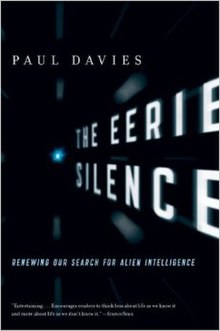The Eerie Silence

Paperback edition
|
|
| Author | Paul Davies |
|---|---|
| Country | United Kingdom |
| Language | English |
| Subject | Astronomy and astrobiology |
| Genre | Non-fiction; science text |
| Publisher | Houghton Mifflin Harcourt |
|
Publication date
|
2010 |
| Media type | Print, e-book |
| Pages | 242 pp. |
| ISBN | |
The Eerie Silence: Renewing Our Search for Alien Intelligence is a 2010 science text by Paul Davies, chair of the SETI: Post-Detection Science and Technology Taskgroup of the International Academy of Astronautics. The Eerie Silence explores the possibilities of intelligent extraterrestrial life, and its potential consequences.
In this chapter, Davies goes over the history of aliens as conceived by humanity, culminating in a discussion about SETI. He makes the point that SETI is science, despite opposing views in the public. Various possibilities for a habitable zone are mentioned, and Davies also debunks various UFO stories.
Here, Davies debates the point of whether life is common in the universe. He discusses two opposing viewpoints: that of Christian de Duve, which is that life will inevitably arise on Earth-like planets given enough time, and that of Jacques Monod, which is that life has only arisen once in the universe, on Earth.
Davies discusses the possibility of multiple biospheres on Earth which evolved separately from normal life, which would be strong evidence for life being a cosmic imperative. He gives several examples of possible shadow lifeforms, as well as various methods to search for them.
In this chapter, Davies analyzes the probability of intelligent life arising on an Earth-like planet and communicating with us. His discussion is centered around the Drake Equation.
Davies argues for a new search method for SETI, which would be less anthropocentric but at the same time scientifically eliminating various uninhabitable regions. He also discusses whether or not we have already received signals from extraterrestrials, but have not yet discovered them.
In this chapter, Davies brings up an interesting theory about habitability on the Galactic Plane. The theory is as such: the Solar system moves up and down relative to the Galactic Plane, in a cycle of 62 million years, wandering 230 light years out of the plane as a result. According to Richard Muller and Robert Rohde, this cycle closely matches that of marine extinctions in the past 542 million years. The death rate is highest when the solar system is located at a maximum distance from the galactic plane in the direction of galactic north and lowest when it is down south.
...
Wikipedia
